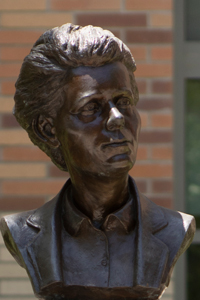»Madame Marie Curie Bust
- Madame Marie Curie
Critical Essay By
Dr. Janeen Hill
Professor Health Sciences, Founding Dean
Crean College of Health and Behavioral Sciences
View Bio
Why does Chapman University display the bust depicting Madame Curie? What lessons can we learn from the obstacles she overcame to become an extraordinary physicist and chemist? What doors did she open for women in science, and were these doors opened equally to all women?
The short answer to the first question is simple. Chapman University displays Madame Curie alongside other notables whose lifetimes were remarkable because she made extraordinary contributions to science over several decades. A few examples illustrate what is meant by her outstanding contributions. She is the first and only person to win Nobel Prizes in two separate sciences, in 1903 for physics and 1911 for chemistry. She shared her first Nobel Prize with her husband, Pierre, and collaborator, Henri Becquerel, for their work proving the existence of radioactivity. Madam Curie received her second Nobel Prize for her discovery of two elements, radium and polonium. She applied the discovery of radiation to develop portable x-ray machines. World War I field hospitals used these to diagnose life-threatening injuries sustained by soldiers. She conceived of ways to use radiation in medicine to treat tumors and sterilize infected tissue. She published a 900+ page treatise on radioactivity. She established the Institut Curie in Warsaw, Poland, and Paris, France. Research scientists in these institutes, still in existence today, discovered a third element, francium, and artificial radioactivity. They have applied these discoveries to advances in cancer treatment.
Madam Curie was born Maria Salomea Skłodowska in Poland in 1867. From her childhood years to her death in 1934, her life was shaped by three critical factors. First, her parents bucked the prevailing trend in Poland to devalue the education of young girls and to make illegal university education for young women. Her parents supplemented her early education with at-home enrichment and then supported her relocation to the Sorbonne in Paris to pursue a university education. Second, her grandfather and father were highly educated physicists, chemists, and mathematicians. Others in her family showed a propensity for the physical sciences. She, too, was innately intelligent and demonstrated the intellectual capacity and curiosity for the physical sciences and mathematics. Third, an unrelenting work ethic driving her approach to science defined Madam Curie. She toiled relentlessly mostly when experiments were not successful or when she was in pursuit of answers to hard questions. Thus, Madam Curies’ environment, inheritance, and work ethic set the stage for her Nobel Prize-winning work.
The effects of radiation on health were unknown when Madam Curie devised ways to apply radiation to the human condition. She spent decades working with radioactive elements radon and polonium, oblivious of the effects of radioactivity on human health. She died of aplastic anemia in 1934, the consequence of long-term exposure to radiation. To this day, her lab books, which would provide clues to her approaches to problem-solving, register a high level of radioactivity, rendering them unavailable for examination.
Male scientist, who doubted the intellect of women, attempted to undermine her career and question her discoveries because of gender. In her early university years, although the Sorbonne admitted her to study science, the university did not provide her appropriate lab space to pursue her studies. (Note: Her future husband offered to share his lab – an offer that established a lifetime collaboration between the two.) Additionally, some members of the Nobel Prize committee and other scientists doubted a woman would have the intelligence to discover new elements and to build upon their properties to imagine and develop useful applications. Their doubts nearly undermined her two Nobel Prizes. Finally, she was twice-denied membership in the French Academy of Science based on her gender with the unspoken doubts about a woman’s intelligence.
No doubt, Madam Curie’s life is a tale of a brilliant woman whose hard work and imagination led to Nobel Prize-winning discoveries. However, the not-oft told story is one about the challenges she faced because of her gender – challenges to become educated, challenges to receive recognition for extraordinary science, challenges to value a woman’s intelligence. These she doggedly overcame. But her efforts to overcome the biases against her did not open the doors and pave a smooth pathway for future women to become a scientist. Today, almost 90 years since her death, women in science are still overcoming challenges to be recognized as an intellectually capable scientist. Women are underrepresented in STEM fields. Women hold the minority of endowed chairs of science and the rank of tenured professor in the sciences at Universities. And, most concerning, upsetting, and shameful, for each of the challenges facing women in science today, the challenges are almost insurmountable for young girls of color who aspire to enter STEM fields and for women of color who are seeking successful academic careers in STEM fields.
The bust of Madam Curie is rightfully displayed on the Orange Campus as a tribute to her science and as a reminder of the hard-fought battles she waged to secure her standing in the scientific community. Now, however, when we look at her image, we should also be compelled to re-double our efforts to secure opportunities for young black girls with a propensity for science and for black women undergraduate and graduate students, post-doctoral research fellows, and faculty members seeking academic careers in STEM.
Collection of Historical Figures Map

Dedicated
November 7, 2012
Designation Name
The Warren D. Hancock Chair in Natural Sciences
Campus Location
Sodaro Promenade, Orange Campus